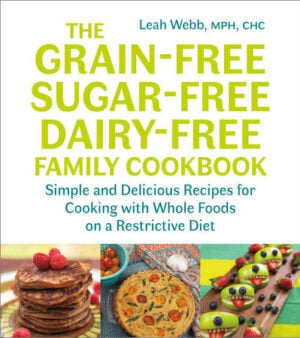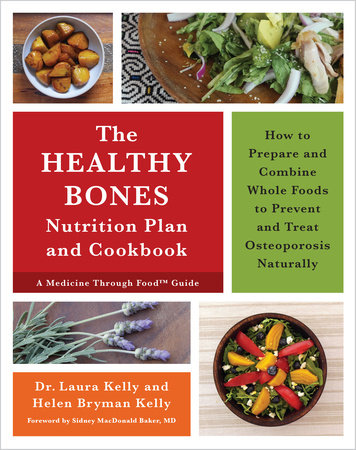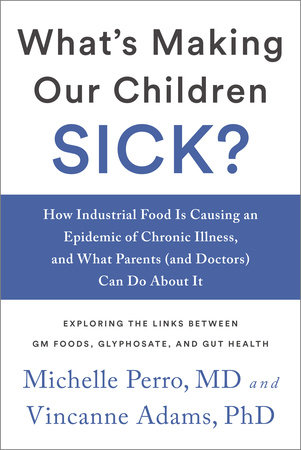A Guide to Sourcing Food: Quality Matters

Living a healthy lifestyle can be challenging, especially when it comes to buying and sourcing food. You want to keep a budget but don’t want to sacrifice good quality or you’re not sure where to get the best products? The first step is to take the time and see what you have access to– farmer’s markets, co-ops, and natural grocery stores are a great start!
The following is an excerpt from The Grain-Free, Sugar-Free, Dairy-Free Family Cookbook by Leah Webb. It has been adapted for the web.
Figuring out where to buy certain foods at the best price and quality will take some time and effort on your part. Quality makes a difference, so it’s worth taking the time to shop around and find a respectable product that’s within your budget.
When it comes to animal products, don’t skimp.
I know this is a challenge because the sticker price for grass-fed beef or free-range eggs seems unreasonable. The problem is that cheap food products are cheap calories. They even have a different nutrient profile than their mindfully raised equivalent. For example, grass-fed beef has less overall fat, a completely different fatty acid profile, and is higher in omega-3s compared to grain-fed beef. Conventionally raised cattle (grain-fed cattle) have a fatty acid profile that is known to elevate bad cholesterol (LDL) and influence the development of cardiovascular disease. Grass-fed beef doesn’t have this negative impact on the body. It’s worth the extra cost.
I also urge you to consider the environmental implications of consuming conventionally raised animals. According to the EPA, agriculture accounted for 9 percent of our greenhouse gas emissions in 2014, and has been responsible for several negative effects on water and soil pollution. The health of our future planet will deteriorate if we don’t make positive consumer choices. Choosing the right meats is about taking care of your immediate health, and also taking care of our environment and the health of future generations.
I should note that I’m not saying that you have to buy certified organic beef. While organic would be great, you can find sustainably raised, grass-fed beef at many grocery stores or farmers markets. You just need to read the packaging or talk with the farmer to ensure that the beef was actually grass fed (raised on pastures) and doesn’t contain hormones and antibiotics. Also be aware that some grass-fed beef is finished with grains, which increased the fat content and thus enhances the flavor of the beef. However, feeding cattle grain during those final weeks before slaughter negates the benefits of raising those cows on grass, and the fatty acid profile for this beef is then similar to that of a grain-fed cow. Cows should be fed grass from start to finish.
The consumption of fish is another dilemma when it comes to environmental sustainability and personal health.
Fish can accumulate heavy metals in concentrations that exceed concentrations found in their surrounding environment, a process known as bioaccumulation. Furthermore, destructive fishing practices are quickly depleting our ocean resources, which means that we have to choose sustainably harvested (or farm-raised) fish if we want these resources to be available for years to come. The Environmental Working Group (ewg.org) has a fantastic online Seafood Calculator that can help you determine the best fish to consume on a regular basis. You can quickly find the calculator through a Google search. Just plug in the requested information and use the guide to inform your seafood purchases. For canned seafood, Wild Planet brand is a good pick for sustainably harvested fish.
My absolute favorite source for finding fresh, healthy, sustainable foods is our local farmers market.
I like to eat a variety of seasonal foods and shopping at the farmers market guarantees that I’ll be selecting from the freshest ingredients around. Shopping at your local market allows you the opportunity to talk with the farmers about their farming practices, which can help you decide on the best quality produce for the best price. Meeting your farmers and learning about their growing practices is the best way to ensure you’re buying an affordable, superior product. I offer a few more farmers market shopping tips in the next section, Budget-Friendly Solutions, but don’t underestimate the value of local food.
 Having a small vegetable garden is another great way to supplement your family’s food budget.
Having a small vegetable garden is another great way to supplement your family’s food budget.
I have quite a large garden at this point and it supplies my family with a significant portion of our vegetable needs during those peak production months. I still rely heavily on the local farmers, grocery stores, and some online shopping, but my garden is a significant supplementary source of organically grown produce throughout the year. You don’t have to have a large amount of space to grow your own food. If you’re new to gardening, start extremely small, even as small as a container garden, and just see how it goes. The smaller the garden, the higher chance of success, and a successful garden is one that is more likely to be recurring and grow over time (no pun intended).
There are numerous products I use in my kitchen that I simply can’t find at our local farmers market, such as nuts and seeds, some fats, canned fish, olives, and many of the other items I like to keep stocked in my pantry. For those items I look to different stores, and I do the best I can.
For example, small health food stores are often a great source for locally sourced products, but unfortunately, this type of store just isn’t readily available where I live. I’ll also add that I used to do more online shopping than I do now. While I genuinely appreciate the convenience of having food delivered straight to my front door, I don’t appreciate the inconvenience and waste of the packaging. Our pantry area transforms into the staging area for recyclables, and online shopping instantly turns this area into a cluttered mess of cardboard. Is the hassle of dealing with the packaging worth the convenience of the instant deliverables? I’m not so sure it is, which is why I often prefer a monthly trip to Costco or a co-op that’s 40 minutes away to purchase things like almond butter, coconut oil, avocado oil, seaweed snacks, sardines, frozen fruits and vegetables, and a variety of other affordable and often organic products. When I do need to buy products online I try to order as little as possible to cut back on the amount of packaging. It’s important for us to cut back on the amount of packaging. It’s important for us to remember that specialty diets can quickly increase our environmental impact if we aren’t mindful as we implement it. Shopping in bulk and trying to find ingredients locally can reduce this impact.
Is Organic Really Better?
The short answer is yes, organic foods are a better option, a much better option. The complicated answer is that some natural pesticides approved for use on organic crops, such as pyrethrins and rotenone, are equally as toxic for human and environmental health as chemical pesticides. In general, the use of the more harmful organic pesticides is limited to use on extremely large-scale organic farms where monocropping (growing just a handful of crops again and again, which ultimately encourages pest infestations and depletes the soil of nutrients) is the norm. I’ll discuss ways to ensure that you’re accessing better quality food, but I’d like to start by presenting a handful of issues surrounding human health and conventionally grown produce. Keep in mind that I’ve chosen to focus solely on human health; the environmental implications are a whole other issue.
One of the most pronounced benefits I see to consuming organic products is that the use of genetically modified organisms (GMOs) is not permitted in foods that hold the USDA organic certification. GMOs are genetically designed to possess desirable traits. Genes are inserted into a plant’s DNA, and this insertion codes for the creation of varying proteins that can enhance the plant’s capabilities. Proponents of genetic modification (GM) claim that GMOs may be the solution to end world hunger because it allows for the creation of specialized food crops that can be grown in the desert and other less than desirable conditions. There’s potential for developing plants with higher yield, greater nutrient content, and the necessary qualities to satisfy a growing world population.
However, the Institute for Responsible Technology states that “the only two traits that are found in nearly all commercialized GM plants are herbicide tolerance and/or pesticide production.” In short, we’re using GM technology to assist in farming methods that more heavily rely on pesticide use. Soy, corn, cotton, and canola make up the majority of GM crops, with most of these plants being resistant to herbicides such as glyphosate (Roundup) and a lesser amount of having the ability to produce their own pesticides. The benefit to a herbicide resistant plant is that you can repeatedly spray that crop with herbicides in order to suppress the weed population, allowing the GM crop to flourish. Other lesser known GM crops include Hawaiian papaya, zucchinis, sugar beets, and yellow squash. Notice that many GM crops, such as corn, canola, soy, and sugar beets (for making sugar), are ingredients found in processed foods. In fact, up to 80 percent of packaged foods available in the grocery store contain GMOs.
Research shows a wide range of detrimental effects resulting from the consumption of GM foods in animals, such as toxicity in the digestive tract, liver and other organ damage, increased death rates, loss of ability to reproduce, infant mortality, heightened immune responses that can lead to food allergies, and tumors. The FDA has classified GMOs as a generally recognized as safe (GRAS), yet there is a complete lack of evidence supporting this classification. In fact, numerous scientists and international authorities have criticized the United State’s approval of GMOs, saying that these crops should not be released into the food chain until a safety profile is clearly established, a feat that seems near impossible given the growing body of research proving otherwise.
Recommended Reads
Recent Articles
These snacks might be too darn cute to take a bite of! Brighten up snack time this winter using fruits and veggies we all know and love.
Read MoreThe scent of fir trees is a holiday staple 🎄 Imagine sipping a festive cocktail infused with the unmistakable taste of fir ✨ This holiday season, elevate your entertaining game by introducing fir to your menu – from classy cocktails to rustic potatoes!
Read MoreLooking for a way to use that leftover Thanksgiving Turkey? Shake things up this holiday season with a game-changing twist. Serve these easy-to-make appetizers with a side of Vietnamese dipping sauce for an extra kick of flavor!
Read More

 Having a small vegetable garden is another great way to supplement your family’s food budget.
Having a small vegetable garden is another great way to supplement your family’s food budget.







